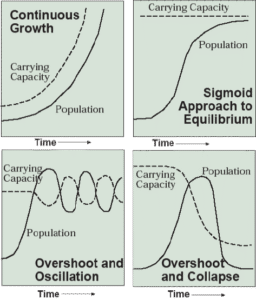Back to: Environmental Biology 100 Level
Welcome to class!
Hello bright mind! Today, we will discuss Population Growth & Environmental Capacity, a topic that explains how the number of people in a place affects the environment’s ability to provide for everyone. Have you noticed how crowded some Nigerian cities like Lagos and Onitsha have become? This rapid increase in population puts pressure on land, water, and other natural resources. By the end of this lesson, you will understand what population growth is, what environmental capacity means, and why balancing the two is important for a healthy future.
Population Growth & Environmental Capacity
Population growth refers to the increase in the number of people living in an area over time. While having more people can mean more development and workforce, it can also lead to challenges such as food shortages, pollution, and poor waste management if the environment cannot support everyone. This is where environmental capacity becomes important.

What is Population Growth?
Population growth is the rise in the number of individuals in a population due to factors like birth rate, reduced death rate, and migration. For example, Nigeria is the most populated country in Africa with over 200 million people, and this number continues to grow.
What is Environmental Capacity?
Environmental capacity, also called carrying capacity, is the maximum number of people an environment can support without being damaged. It is based on the availability of resources like food, water, clean air, and land.
Causes of Population Growth
High Birth Rates: Many families have more children due to cultural and economic reasons.
Better Healthcare: Lower death rates due to improved medicine and hospitals.
Migration: Movement of people to urban areas for jobs and education.
Lack of Family Planning: Limited awareness about population control.
Effects of Rapid Population Growth
Overuse of natural resources like water and farmland.

Increased waste, leading to pollution.
Higher demand for food, housing, and energy.
Deforestation to make space for housing and farming.
Traffic congestion and overcrowding in cities.
Balancing Population Growth with Environmental Capacity
Promoting family planning and education.
Sustainable farming to produce enough food.

Recycling and proper waste management.
Protecting forests and water sources.
Government policies to manage urban development.
Summary
- Population growth is the increase in the number of people living in an area.
- Environmental capacity is the maximum population an environment can support without damage.
- Causes of population growth include high birth rates, migration, and better healthcare.
- Rapid population growth leads to pollution, resource shortages, and deforestation.
- Family planning, recycling, and sustainable development help balance population and environment.
Evaluation
- What is population growth?
- Define environmental capacity in your own words.
- Mention two causes of rapid population growth.
- List three effects of population growth on the environment.
- Suggest two ways to balance population growth with environmental capacity.
Well done, superstar learner! Understanding the link between population and the environment is key to building a sustainable future. Keep learning with Afrilearn—you have all it takes to create positive change in your world!
